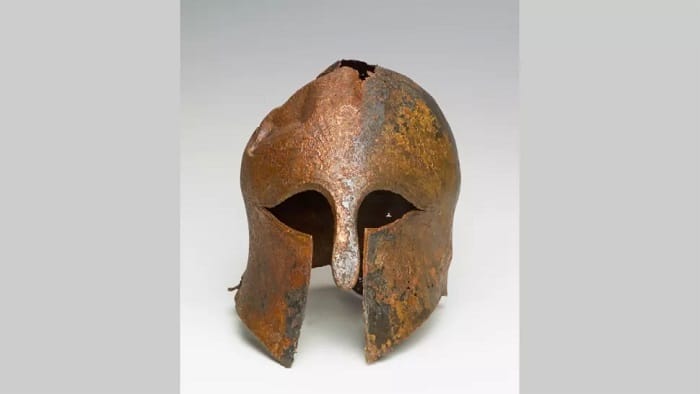

A Greek helmet from the Persian Wars has recently been turned over to Israeli authorities after it was found several years ago.
A statement issued by the Israeli Antiquities Authority says that the soldier to whom the bronze helmet once belonged may have taken part in a counterattack in the ongoing battles against the Persian Empire 2,500 years ago.
The bronze, Corinthian-type helmet, in remarkably intact condition, was most likely worn by a Greek soldier during the Greco-Persian wars.
Found by seamen from a Dutch ship at the port of Haifa in Israel in 2007, the priceless find was only recently turned over to Israeli officials.
The Antiquities Authority announcement says “The helmet belongs to the Corinthian type that takes its name from the city of Corinth in Greece where it was developed in the 6th century BC.”

The statement says the helmet “was masterfully made from a single bronze sheet with heating and forging. This technique allowed the weight to be reduced without reducing the protective capacity.”
This technique made it possible to reduce the weight of the helmet without diminishing its capacity to protect the head of the warrior.
The front of the helmet (the nose and cheek guards) is thicker than its back. The front, above the nose guard and the forehead, is adorned with an engraved and hammered decoration of a peacock’s tail and snakes are incised above the eye slits.
The cheek guards are decorated with a pattern of lions, one on the right side and one on the left.
The director of the Antiquities Authority’s marine department, Coby Sarvit, stated that the helmet “probably belonged to a Greek soldier of the Greek fleet who took part in the attacks against the Persians who dominated the country at that time.”
The owner of the helmet most likely took part in the Greek counterattack that was launched in 479 B.C. against the Persians, whose empire at that time stretched across almost the entire Middle East.
Experts speculate that the headpiece’s owner was a wealthy individual, as most soldiers wouldn’t have been able to afford such elaborate gear.
“The gilding and figural ornaments make this one of the most ornate pieces of early Greek armor discovered,” wrote Sharvit and scholar John Hale in a research summary quoted by UPI.
It is possible however, that as Sarvit noted, that the helmet belonged to a mercenary who was aboard a ship that traded with the nearby coastal settlement at Tell Abu Hawam, near the outlet of Nahal Kishon.
In excavations that were conducted at Tell Abu Hawam in 1932-1933 pottery vessels were found had been imported from Corinth. In the excavations that were carried out there in recent years, on behalf of the University of Haifa and the Antiquities Authority, archaeological strata of a well-planned city were exposed which yielded a large quantity of Greek vessels.
Two previous attempts by the Persians to invade Greece were ultimately unsuccessful. The first, at the Battle of Marathon, just outside Athens, was repulsed in 490 BC., and during the second they were met by the Spartans, under King Leonidas, at the Battle of Thermopylae in 480 BC.
After the Battle of Salamis, the Persians were finally expelled from Greece in 479 BC, but additional battles took place for more than a century until the final conquest of the Persian Empire by Alexander the Great in 330 BC.
